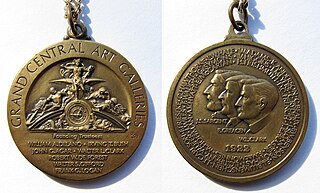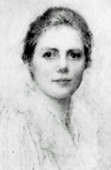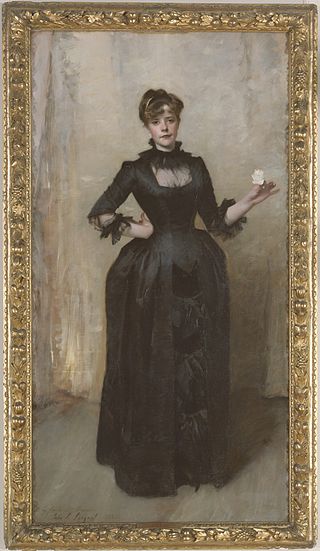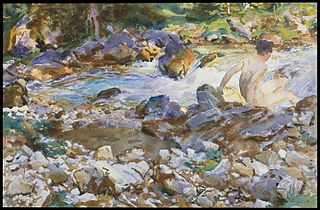
John Singer Sargent was an American expatriate artist, considered the "leading portrait painter of his generation" for his evocations of Edwardian-era luxury. He created roughly 900 oil paintings and more than 2,000 watercolors, as well as countless sketches and charcoal drawings. His oeuvre documents worldwide travel, from Venice to the Tyrol, Corfu, Spain, the Middle East, Montana, Maine, and Florida.

Watercolor or watercolour, also aquarelle, is a painting method in which the paints are made of pigments suspended in a water-based solution. Watercolor refers to both the medium and the resulting artwork. Aquarelles painted with water-soluble colored ink instead of modern water colors are called aquarellum atramento by experts. However, this term has now tended to pass out of use.

Madame X or Portrait of Madame X is a portrait painting by John Singer Sargent of a young socialite, Virginie Amélie Avegno Gautreau, wife of the French banker Pierre Gautreau. Madame X was painted not as a commission, but at the request of Sargent. It is a study in opposition. Sargent shows a woman posing in a black satin dress with jeweled straps, a dress that reveals and hides at the same time. The portrait is characterized by the pale flesh tone of the subject contrasted against a dark-colored dress and background.

Paul César Helleu was a French oil painter, pastel artist, drypoint etcher, and designer, best known for his numerous portraits of beautiful society women of the Belle Époque. He also conceived the ceiling mural of night sky constellations for Grand Central Terminal in New York City. He was also the father of Jean Helleu and the grandfather of Jacques Helleu, both artistic directors for Parfums Chanel.

Walter Gay was an American painter noted both for his genre paintings of French peasants, paintings of opulent interior scenes and was a notable art collector.

The Grand Central Art Galleries were the exhibition and administrative space of the nonprofit Painters and Sculptors Gallery Association, an artists' cooperative established in 1922 by Walter Leighton Clark together with John Singer Sargent, Edmund Greacen, and others. Artists closely associated with the Grand Central Art Galleries included Hovsep Pushman, George de Forest Brush, and especially Sargent, whose posthumous show took place there in 1928.

Street in Venice is a c. 1882 oil on wood painting by the American artist John Singer Sargent (1856–1925). Painted in a post-impressionist manner, it is set in a quiet backstreet off the Calle Larga dei Proverbi, near the Grand Canal in Venice. The painting shows a young woman walking along the flagstones, kicking her skirt with her right foot, and observed by two men in the shadows to her right. From the manner in which Sargent depicts her down-turned eyes and seemingly fast pace with which she passes the two men, he is concerned largely with the invasive male glare and its effect on the passing woman.

El Jaleo is a large painting by John Singer Sargent, depicting a Spanish Romani dancer performing to the accompaniment of musicians. Painted in 1882, it currently hangs in the Isabella Stewart Gardner Museum in Boston.

Lucia Fairchild Fuller was an American painter and member of the New Hampshire Cornish Art Colony. She was inspired to pursue art by John Singer Sargent. Fuller created a mural entitled TheWomen of Plymouth for the Woman's Building at the World's Columbian Exposition in Chicago in 1893. Best known for her portrait miniatures, she was a founding member and treasurer of the American Society of Miniature Painters.

Carnation, Lily, Lily, Rose is an oil-on-canvas painting made by the American painter John Singer Sargent in 1885–86.

Lady with the Rose (Charlotte Louise Burckhardt) is an 1882 painting by John Singer Sargent. It is part of the collection of the Metropolitan Museum of Art in New York City.

The Wyndham Sisters: Lady Elcho, Mrs. Adeane, and Mrs. Tennant is an 1899 painting by John Singer Sargent. It is part of the collection of the Metropolitan Museum of Art. The painting was hailed by the critics and dubbed “The Three Graces” by the Prince of Wales.

Egyptians Raising Water from the Nile is an 1890–1891 painting by John Singer Sargent. It is part of the collection of the Metropolitan Museum of Art, New York City, United States.

Bringing Down Marble from the Quarries to Carrara is a 1911 painting by John Singer Sargent which is part of the collection of the Metropolitan Museum of Art.

Mountain Stream is an early 20th century watercolor drawing by the American artist John Singer Sargent. Done in watercolor and graphite pencil on wove paper, the work depicts a nude figure by a dazzling mountain stream. Sargent's work was donated to the Metropolitan Museum of Art, where it remains, as part of the bequest of Joseph Pulitzer in 1915.

Egyptian Woman with Earrings is a late 19th-century painting by American artist John Singer Sargent. Done in oil on canvas, the work portrays an Egyptian woman. The painting is in the collection of the Metropolitan Museum of Art in New York.

Tommies Bathing is a 1918 watercolor painting by John Singer Sargent. It is in the collection of the Metropolitan Museum of Art.

Splendid Mountain Watercolours or Splendid Mountain Sketchbook is a collection of sketches and watercolors by John Singer Sargent (1856–1925), executed when he was fourteen years old, and on a summer excursion to Switzerland's Bernese Alps in the Berner Oberland in 1870. The sketchbook contains 60 leaves, including 14 watercolors and 47 crayon or graphite studies of the mountains, landscapes and people he encountered while traveling with his family.

Grace Hoops is a genre painting by the American artist Winslow Homer. It depicts two young women outdoors playing the game of graces. Scenes of childhood innocence constituted one of Homer's recurring subjects throughout the 1870s. The work is now in the collection of the McMullen Museum of Art at Boston College, having been donated as part of the Carolyn A. and Peter S. Lynch collection.



















